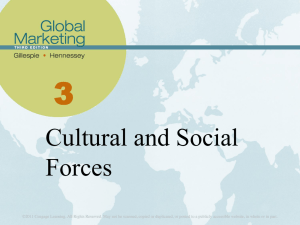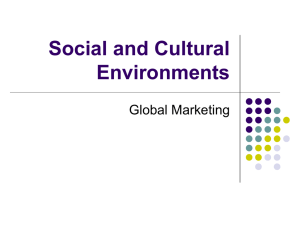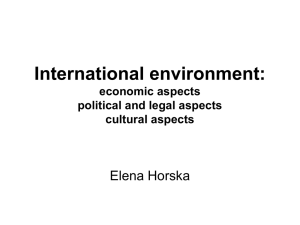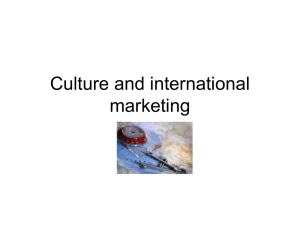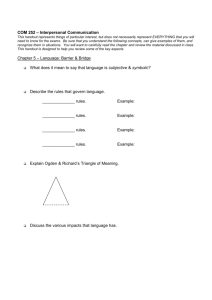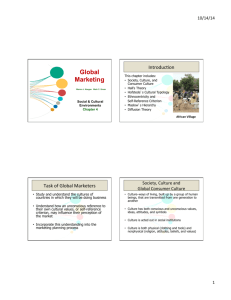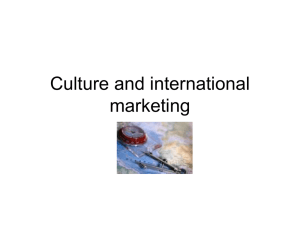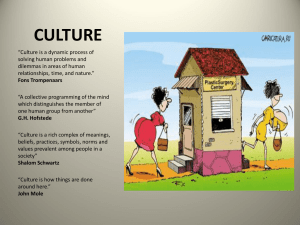Chapter 4 Social and Cultural Environments
advertisement
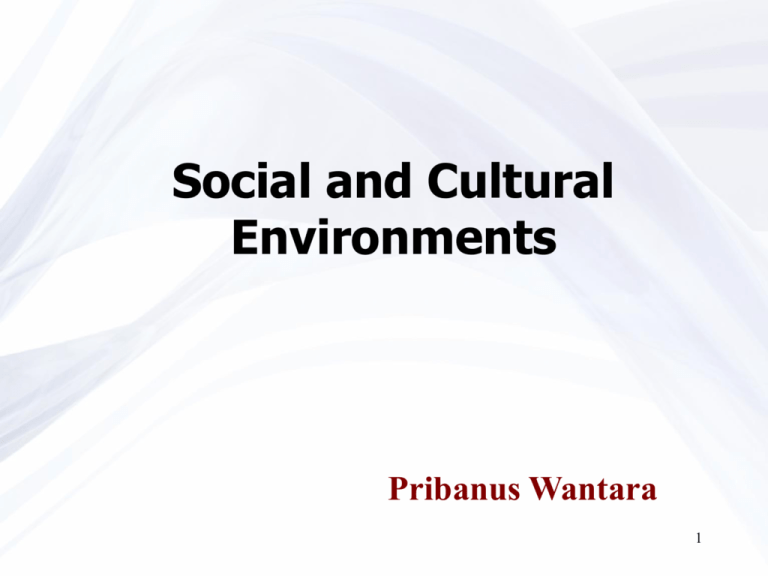
Social and Cultural Environments Pribanus Wantara 1 Introduction This chapter includes: • Society, Culture, and Consumer Culture • Ethnocentricity and Self-Reference Criterion • Hall’s Theory • Maslow’s Hierarchy • Hofstede’s Cultural Typology • Diffusion Theory African Market 4-2 Task of Global Marketers • Study and understand the cultures of countries in which they will be doing business • Understand how an unconscious reference to their own cultural values, or self-reference criterion, may influence their perception of the market • Incorporate this understanding into the marketing planning process 4-3 Society, Culture, and Global Consumer Culture • Culture–ways of living, built up by a group of human beings, that are transmitted from one generation to another • Culture has both conscious and unconscious values, ideas, attitudes, and symbols • Culture is acted out in social institutions • Culture is both physical (clothing and tools) and nonphysical (religion, attitudes, beliefs, and values) 4-4 Social Institutions • • • • • Family Education Religion Government Business These institutions function to reinforce cultural norms 4-5 Material and Nonmaterial Culture • Physical component or physical culture – Clothing – Tools – Decorative art – Body adornment – Homes • Subjective or abstract culture – Religion – Perceptions – Attitudes – Beliefs – Values 4-6 Society, Culture, and Global Consumer Culture “Culture is the collective programming of the mind that distinguishes the members of one category of people from those of another.” Geert Hofstede • A nation, an ethic group, a gender group, an organization, or a family may be considered as a category. 4-7 Society, Culture, and Global Consumer Culture • Global consumer cultures are emerging – Persons who share meaningful sets of consumptionrelated symbols – Pub culture, coffee culture, fast-food culture, credit card culture • Primarily the product of a technologically interconnected world – Internet – Satellite TV – Cell phones 4-8 Attitudes, Beliefs, and Values • Attitude–learned tendency to respond in a consistent way to a given object or entity • Belief–an organized pattern of knowledge that an individual holds to be true about the world • Value–enduring belief or feeling that a specific mode of conduct is personally or socially preferable to another mode of conduct 4-9 Religion • The world’s major religions include Buddhism, Hinduism, Islam, Judaism, and Christianity and are an important source of beliefs, attitudes, and values. • Religious tenets, practices, holidays, and history impact global marketing activities. 4-10 Religion • • • • McDonald’s does not serve beef hamburgers in India because Hindus do not eat beef. There were objections raised in the merger of Daimler-Benz and Chrysler relating to Jewish history and the Holocaust. Some Muslims have tapped into anti-American sentiment by urging a boycott of American brands due to U.S. military action in the Mideast following 9/11. Europeans are divided on the issue of referring to God and Christianity in a new European constitution. Strong Catholic countries like Ireland, Spain, Italy, and Poland are for inclusion. France and Belgium are strong advocates of separation of church and state. Europe’s politically active Muslim minority are resisting inclusion of Christianity in the EU Constitution. 4-11 Aesthetics • The sense of what is beautiful and what is not beautiful • What represents good taste as opposed to tastelessness or even obscenity • Visual–embodied in the color or shape of a product, label, or package • Styles–various degrees of complexity, for example, are perceived differently around the world 4-12 Aesthetics and Color • Red–associated with blood, wine-making, activity, heat, and vibrancy in many countries but is poorly received in some African countries. • White–identified with purity and cleanliness in the West, with death in parts of Asia. • Gray–means inexpensive in Japan and China, but high quality and expensive in the U.S. 4-13 Aesthetics and Color • Some colors may be used in all countries, i.e., Caterpillar yellow, Marlboro’s red chevron. Colors may need to be adapted according to local cultural preferences. • Soft drink labels and color associated with good taste: Chinese associate brown. South Koreans and Japanese associate yellow. Americans associate red. 4-14 The Meaning of Color Yellow indicates a merchant in India Red signifies good luck and celebration in China In England and the U.S., “Something Blue” on a bride’s garter symbolizes fidelity 4-15 Dietary Preferences • Domino’s Pizza pulled out of Italy because its products were seen as “too American” with bold tomato sauce and heavy toppings. • Subway had to educate Indians about the benefits of sandwiches because they do not normally eat bread. 4-16 Language and Communication Linguistic Category Language Example Syntax-rules of sentence English has relatively fixed word order; Russian has relatively free word order. Semantics-system of Japanese words convey nuances of feeling for which other languages lack exact correlations; ‘yes’ and ‘no’ can be interpreted differently than in other languages. Phonology-system of Japanese does not distinguish between the sounds ‘l’ and ‘r’; English and Russian both have ‘l’ and ‘r’ sounds. Morphology-word Russian is a highly inflected language, with six different case endings for nouns and adjectives; English has fewer inflections. 4-17 formation meaning sound patterns formation Language and Communication • Speaking English around the Globe – There are more people who speak English as a foreign language than native speakers – 85% of European teens study English – Sony, Nokia, Matsushita require managers to speak English • Nonverbal Communication – Westerners tend to be verbal; Asians value nonverbal communication – In Japan, bowing has many nuances – In the Mideast, Westerners should not show the soles of shoes or pass documents with the left hand 4-18 Marketing’s Impact on Culture • Universal aspects of the cultural environment represent opportunities to standardize elements of a marketing program • Increasing travel and improved communications have contributed to a convergence of tastes and preferences in a number of product categories 4-19 Controversy Surrounding Marketing’s Impact on Culture • “McDonaldization of culture” “Eating is at the heart of most cultures and for many it is something on which much time, attention, and money are lavished. In attempting to alter the way people eat, McDonaldization poses a profound threat to the entire cultural complex of many societies.” -George Ritzer • Protest against the opening of McDonald’s in Rome led to the establishment of the Slow Food movement 4-20 High- and Low-Context Cultures • High Context – Information resides in context – Emphasis on background, basic values, societal status – Less emphasis on legal paperwork – Focus on personal reputation • Saudi Arabia, Japan • Low Context – Messages are explicit and specific – Words carry all information – Reliance on legal paperwork – Focus on non-personal documentation of credibility • Switzerland, U.S., Germany 4-21 High- and Low-Context Cultures Factor/Dimension High Context Low Context Lawyers (pengacara) Less Important Very Important A person’s word Is his/her bond Is not reliable–get it in writing Responsibility for Organizational error Taken by highest level Pushed to the lowest level Space People breathe on each other Private space maintained Time Polychronic Monochronic Competitive Bidding Infrequent Common 4-22 High- and Low-Context Cultures Factor/Dimension High Context Low Context Lawyers (pengacara) Less Important Very Important Kata-kata seseorang Is not reliable–get it in writing Tidak dapat diandalkan, mendapatkannya secara tertulis Is his/her bond Apakah ikatan nya tanggung jawab Taken by highest level Kesalahan organisasi Diambil oleh tingkat tertinggi Pushed to the lowest level Didorong ke Pesan tingkat awal Ruang Orang bernapas satu sama lain Ruang pribadi dipertahankan Time Polychronic Monochronic Penawaran Pembelian Kompetitif Infrequent (jarang) Common (umum) 4-23 Hofstede’s Cultural Typology • • • • • Power Distance Individualism/Collectivism Masculinity Uncertainty Avoidance Long-term Orientation 4-24 Self-Reference Criterion and Perception • Unconscious reference to one’s own cultural values; creates cultural myopia • How to Reduce Cultural Myopia: – Define the problem or goal in terms of home country cultural traits – Define the problem in terms of host-country cultural traits; make no value judgments – Isolate the SRC influence and examine it – Redefine the problem without the SRC influence and solve for the host country situation 4-25 Diffusion Theory: The Adoption Process • The mental stages through which an individual passes from the time of his or her first knowledge of an innovation to the time of product adoption or purchase – – – – – Awareness Interest Evaluation Trial Adoption 4-26 Diffusion Theory: Characteristics of Innovations • Innovation is something new; five factors that affect the rate at which innovations are adopted include: – Relative advantage – Compatibility – Complexity – Divisibility – Communicability 4-27 Diffusion Theory: Adopter Categories 4-28 Marketing Implications • Cultural factors must be considered when marketing consumer and industrial products • Environmental sensitivity reflects the extent to which products must be adapted to the culture-specific needs of different national markets 4-29 Environmental Sensitivity 4-30 Environmental Sensitivity • Independent of social class and income, culture is a significant influence on consumption and purchasing • Food is the most culturally-sensitive category of consumer goods – Dehydrated Knorr Soups did not gain popularity in the U.S. market that preferred canned soups – Starbucks overcame cultural barriers in Great Britain and had 466 outlets by 2005 4-31 Looking Ahead to Chapter 5 • The Political, Legal, and Regulatory Environments of Marketing 4-32
